The Catholic Church in the Cook Islands
The Cook Islands has a population of 11,900 people living on a land mass of 240 square kms. The diocese has a Catholic population listed at 2,040. This gives the opportunity to every parish priest I meet to say that his parish is larger than the diocese of the Cook Islands. ‘Small’ is a reality in the Diocese of Rarotonga. This has tremendous advantages, for as a shepherd, I have the opportunity to be known personally by all my sheep. When ministering the Sacraments, each candidate is known to the bishop and likewise their families.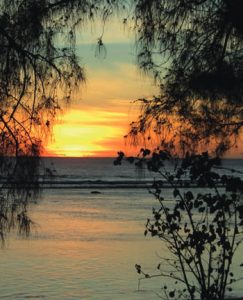
The above reality can be misleading in what is not stated: namely, the fact that the 15 small islands of the Cook Islands are spread out over 2,000,000 square kms of ocean; that to reach an island in the north of the country will take a 10 day sea journey on an uncomfortable boat or if one is lucky enough to fly, a one way ticket will cost NZ$1800. At this price, it would be cheaper to fly to Rome. Then, having landed by boat or plane, one has to live with the uncertainty that the next boat or plane may be two or more months away. I have been bishop of the diocese of Rarotonga for five years and there are three islands I have yet to visit.
London Missionary Society missionaries arrived in the Cook Islands from Tahiti in 1821 and were successful in converting Cook Islanders to Christianity. Catholic missionaries were invited in 1894, principally to provide education. Many of the missionary priests taught in schools and the Sisters of St Joseph of Cluny were on the scene in 1895 in establishing St Joseph’s Catholic Primary School, which continues today. In 1975, Bishop John Rodgers sm saw the need for a Catholic secondary school, and this was built and eventually staffed by the Christian Brothers, Sisters and lay teachers. Through the schools, converts from London Missionary Society (now the Cook Islands Christian Church) became the foundation members of the Catholic Church.
The original priests and brothers for the Cook Islands were members of the Congregation of the Sacred Hearts of Jesus and Mary (ss.cc), commonly known as ‘Picpus Fathers.’ Since 1894, this Congregation has sent 41 Priests and two Brothers to minister in the country. Two men, from the Netherlands, are to this day living in the diocese: Fr. John Rovers, at age 88, still ministers to parishes on Mauke; and Fr Damian Marinus (87) has the important ministry of praying for the diocese. Currently, three priests from the Missionaries of the Philippines are working in the diocese. There is also one diocesan priest, Fr Freddy Kaina, and a deacon, who will be ordained priest by the end of the year. There are two members of the Sisters of St. Joseph of Cluny ministering in the diocese.
The topic of vocations is frequently a conversation point, given that there are six priests and two Sisters. The diocese does not have a current priestly or religious vocation. This is a serious concern for the future of the diocese. But it is not a point to berate the people about, as I am sure there are many parishes of fewer than 2,000 people in New Zealand and elsewhere who have no vocations. Signs of the times have to be addressed and my focus is switching to study the methods of the first Catholic missionary to the Cook Islands, Mgr. Bernardin Castanié ss.cc, who set up the diocese with few resources.
Shortage of personnel is something with which we will have to live, given the world shortage of vocations. Over recent years, the Picpus Fathers have prioritised their mission, as have the Christian Brothers, the Society of Mary, the Daughters of Charity, the diocesan priests on loan from Tonga and the Sisters of Our Lady of Nazareth - all of whom have withdrawn their commitment to the diocese. The smallness of the catholic population in the Cook Islands cannot compete with the greater need elsewhere in the world. The people of the Cook Islands are conscious of the richness which Religious personnel bring to their daily life. Something is missing without the presence of Religious. Yet, God does provide in another way and the local church benefits from its local Catechists.
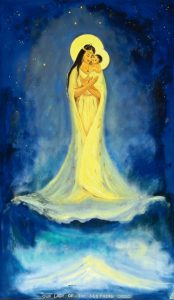
Our Lady of the Southern Cross, St Paul’s Church, Titikaveka, Rarotonga. Painting by Sister Mary Lawrence RSM (Julia Lynch) Photo: Joseph Nguyen
Many islands are without priests and it is the Catechists, together with their wives, who minister to these communities. These Catechists minister, often in isolation from regular visits from the priest. I highlight this point by writing about St. Teresa’s parish on the island of Nassau. There are perhaps 40 Catholics who were visited by a priest two years ago. He was able to stay on the island only three hours before the boat moved on. Nassau had not seen a priest for 13 years. My problem is how to train these men and their wives given their isolation. The situation is not impossible, as these isolated islands have good internet and a good deal of information can be passed on to them through this media. The diocese has 27 Catechists in all, five working in complete isolation from a priest.
Today, there are six major Christian denominations in the country recognized by the Government: The Cook Islands Christian Church (50%); Catholic Church (17%); Seventh Day Adventist (8%); Latter Day Saints (4.5%) the Assemblies of God (4%) and the Apostolic Church (2%). Other religions, sects or of no religion (14.5%). Again, because of the smallness of the population, one cannot ignore or pretend other denominations do not exist. At an official level, the leaders of various churches meet regularly. In the Cook Islands every official, business and social occasion will have a prayer component, led by one or more denominations. The government and business occasions with a prayer component are key moments for evangelisation. The social teachings of the Church can be used in these circumstances and, considering the exposure Pope Francis is given in the local press, the public is generally up to date and open to what he is saying.
Depopulation has to be addressed in any article on the Cook Islands. I was consecrated bishop in 2011 when the population was 16,000. Since then it has declined to 11,900. This decline is more noticeable in the outer islands than on Rarotonga. Saddest for me is the island of Rakahanga which once had a priest residing on the island itself, which would suggest a vibrant Catholic community. Two years ago when I visited, I found two Catholics. In the 2013 census in New Zealand, the Cook Island Maori population residing in NZ was 61,839. Australia, in its 2011 census, has the Cook Island component of the population at 6,092. If 17% of Cook Islanders are Catholic, that means that there should be about 10,500 Cook Island Catholics in New Zealand. The New Zealand bishops have more Cook Islanders to shepherd than I do!
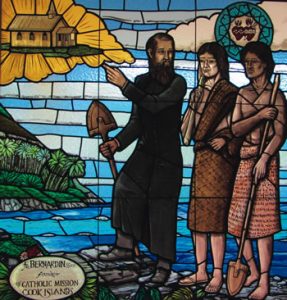
Fr Bernardin Castanié, Founder of the Cook Islands’ Catholic Mission - window in St Joseph’s Cathedral
The diocese of Rarotonga is a member of the CEPAC (‘Conferentia Episcopalis Pacifici’) Bishops’ Conference. Every time I travel to a meeting of the Conference, I have to pass through New Zealand. In the Conference for the last five years I have been the bishop responsible for Mission and Unity. This had me as the bishop responsible for Propagation of the Faith activities, and, on the Unity desk, the bishop who attended meetings with other church leaders who are members of the Pacific Conference of Churches. Currently my responsibility is being President of the CEPAC Bishops’ Conference.
In 2011 when I was named bishop for Rarotonga, the country and people were unknown to me, as my experience was in the west Pacific. The joy I experience as a bishop, is the welcome I have been given, even though initially I was a stranger to the diocese. Serious issues have cropped up in that time such as an arsonist burning six modern classrooms in the Catholic Secondary School. Negotiations over lease renewals on most of the church properties have come due. Financially, these have been costly exercises but the people have been generous.
I note that these are all material matters. It has been the Year of Faith (2013) and the Year of Mercy (2016) that have provided valuable opportunities to develop the faith. The laity have become more aware of what it is to live the Gospel and are very receptive to the teachings they receive, especially through the homilies. The church is not just the land and buildings. What is important is that our people are helped to continue evangelising themselves in the name of Christ.
My motto highlights our joint responsibility in our faith journey: ‘Together in Christ.’
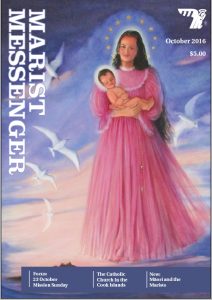
The painting of Mary and the baby Jesus is in St Joseph’s Cathedral, Avarua, Rarotonga, Cook Islands. The artist is Jillian Sobieska, and the painting dates from 1994.
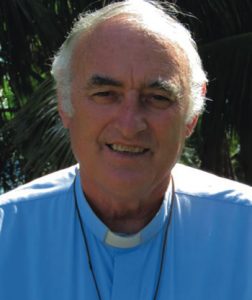
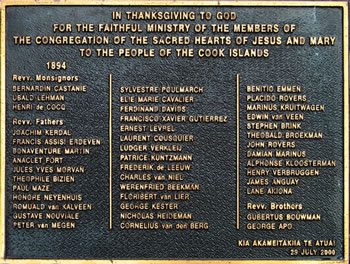
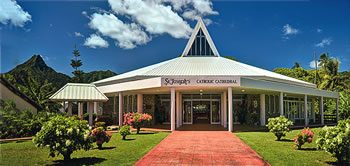
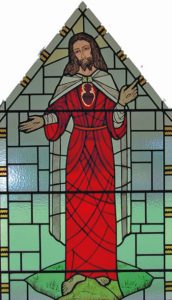
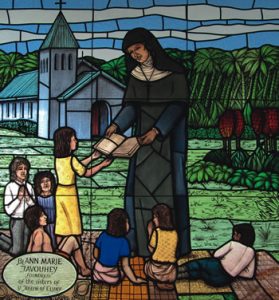
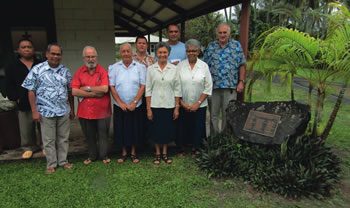
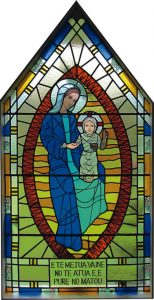
 Entries(RSS)
Entries(RSS)
Thank you Bishop Paul,
An excellent report. Will continue to pray for his mercy upon you and us the people of the Cook Islands.
Meitaki maata
Dear Bishop Paul
I loved all the art work and photos that you included in your article. Thank you for always including us in your emails. It's how we stay connected with our dear friends in the Cook Islands. We continue to hold all of you in our prayers. Love and blessings from Australia, Kathy, David, Hannah Rose and Rebecca Ann xo